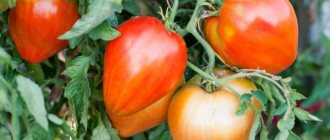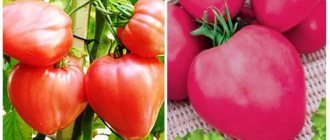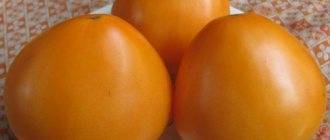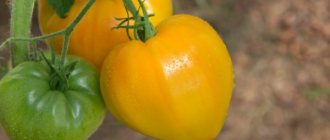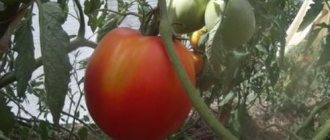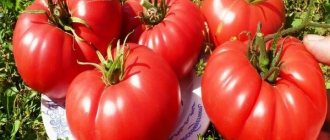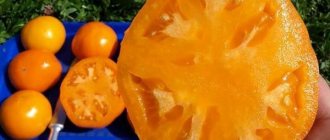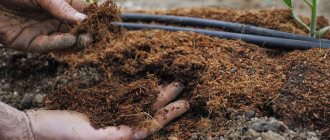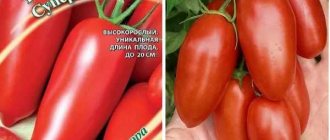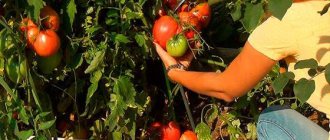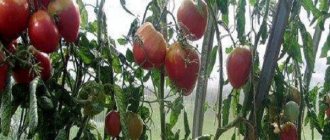Tomatoes are the most favorite vegetable of most gardeners, not only in Russia, but also in other countries. For example, in the USA, 93% of garden plots are sown with tomatoes. That is why every year the State Registers of different countries are replenished with new names of tomato crops. Russia is one of the leaders among varietal developments, characterized by increased adaptation to any weather conditions and excellent taste properties of ripe fruits.
Today we will talk about the Loving Heart red tomato, which, despite its short existence, already has many loyal fans among summer residents.
Characteristics and description of the tomato variety Loving Heart red
offers to evaluate the new tomato variety Loving Heart Red. The variety is young, is under experimental testing, and therefore has not yet been included in the State Register of Breeding Achievements.
The plant type is indeterminate, which means unlimited growth of the main stem. To determine the growth point, pinching is carried out. Height is 1.6-2 m. On one seedling, 5-6 fruit-bearing branches are formed, 1 branch bears 5-7 fruits. The stem is powerful, the foliage is medium. The first inflorescence is formed above the eighth leaf.
A mid-early species, 95–110 days pass from the moment of sowing the seeds to full ripening. It is distinguished by increased immunity to dangerous diseases of the nightshade family and good adaptation to unfavorable climatic conditions. Recommended for cultivation in open ground and greenhouse conditions.
The yield is high: 10–15 kg are harvested from one seedling, provided that 3–4 plants are planted per 1 square meter. m.
The culture requires obligatory staking and regular pinching due to the large number of side shoots.
Description of fruits
Average weight - 600–800 g, heart-shaped, bright red color. The taste is sweet and delicate, harmoniously combined with spicy sourness. The pulp is juicy, fleshy, there are a lot of seeds. The peel is thin, so tomatoes do not have a long shelf life. Ripe vegetables are immediately used for food or for processing to prepare tomato products.
The purpose of the fruit is universal. Perfect for any fresh dishes and for winter preparations. Delicious juices, pastes, ketchups and adjika are obtained from these tomatoes.
The photo shows Loving Heart tomatoes.
Harvesting
Ripe tomatoes need to be harvested every three to four days. Tomatoes are cut together with the stalk. To store Loving Heart tomatoes, select a dry, ventilated room with a normal humidity level. To keep tomatoes better preserved and not damaged, it is better to place them in boxes covered with paper.
In regions with short summers, not all tomatoes have time to ripen. Therefore, with the onset of cold weather, all fruits (of any degree of maturity) are collected. To ripen, they are placed in a cool, dry room. Among the green tomatoes, several ripe fruits are left. Ripe tomatoes produce ethylene, which promotes rapid ripening of other unripe fruits.
Growing tomatoes doesn't require much time or effort. Simple rules for caring for a tomato of the Loving Heart variety will allow even novice gardeners to get a magnificent harvest.
Pros and cons of the variety
Like any other variety, this tomato has positive and negative sides.
The benefits include:
- high productivity;
- adaptation to any weather changes;
- disease resistance;
- possibility of growing in a greenhouse and in open beds;
- ease of care;
- excellent taste;
- large fruits;
- versatility in cooking.
In addition to the above advantages, you can add one more, which is important for gardeners. The culture is not a hybrid and retains the parental genes in the next generation. This means that each gardener will be able to prepare seeds for the next planting on their own.
Disadvantages of the variety:
- obligatory garter;
- regular stepsoning;
- short shelf life of ripe vegetables;
- poor transportability.
Despite the last 2 points, the crop is grown on an industrial scale due to its high yield. Tomato is in considerable demand in markets.
Features of growing the variety
At home, seedlings are grown for more than 2 months - usually 65-70 days. Planting begins at the end of February or beginning of March. The seeds are pre-prepared - they are immersed in a saline solution (5%) and the floating ones are removed, and 3-4 hours before planting they are soaked in a growth stimulant (Zircon, Epin or aloe juice with water in equal quantities).
You can choose any containers - wooden boxes, plastic containers, cassettes or peat tablets (so as not to pick up the seedlings) are suitable. The soil can be purchased or prepared in advance from turf soil, compost and humus (2:1:1). First you need to put it in the freezer for several days or keep it in the oven for 15 minutes at a temperature of 150 degrees.
Seeds are planted to a depth of 1.5 cm and greenhouse conditions are immediately created (moistened, covered with glass, grown at a temperature of 25-27 degrees). Dive after 2-3 leaves appear (container volume is at least 200 ml). Then they are given a complex fertilizer and grown at room temperature.
Advice! To prevent seedlings from stretching, it is advisable to lower the temperature to 17-18 degrees at night.
In most regions, Loving Heart tomatoes are best grown in a greenhouse
Plants are transplanted into the greenhouse in mid-May. Place a tablespoon of ash in the hole and water it generously. Then they give water 2 times a week, and complex and organic fertilizers - 2 times a month. The soil is mulched, periodically loosened and weeded. The Loving Heart tomato bush is formed into 2 stems, pinched and tied to a support.
How to grow a tomato
The Red Loving Heart tomato does not belong to capricious crops. During the entire growing season, regular watering and several feedings are enough for it.
Planting stages
Like many varietal crops, tomato is propagated through seedlings. Sowing of seeds begins 2 months before planting in the ground. But before sowing, it is necessary to carry out a number of measures to improve their germination.
Select a container and prepare the seeds for sowing
The initial stage of preparation is seed rejection. The seed material is laid out on the table and carefully inspected for visible damage. Then they check for emptiness, since empty seeds will not germinate. To determine the emptiness of seeds, 1 teaspoon of salt is dissolved in a glass of water, and the grains are placed in the solution for 10 minutes.
Those that float to the surface are disposed of. The remaining seeds are disinfected in a weak solution of potassium permanganate for 20 minutes. They are then washed with running water and dried.
Important ! The main goal of seed disinfection is the prevention of diseases and pests.
To improve germination, seeds are placed in growth stimulants for 10 hours. Such drugs include “Epin” or “Kornevin”. In addition to specialized substances, aloe juice or melt water performs the function of a stimulant.
Reference . Melt water can be obtained from melted snow. But before soaking the seeds, it must be warmed to room temperature.
As for the container, you can plant it in a common container or in individual containers. The common container is a wooden box, and individual containers are plastic and peat cups. If the container was used for last year's plantings, it must be disinfected with a weak solution of manganese, as pathogenic spores may remain in it.
In the prepared containers, small drainage holes are made at the bottom, where excess moisture will drain. Drainage holes are especially necessary in plastic cups to avoid the development of diseases such as blackleg.
Reference . Blackleg is a fungal disease characteristic of the seedling period. Causes lodging of seedlings and their death.
The soil is prepared from garden soil, peat and humus in equal quantities. River sand is added as a leavening agent. After thoroughly mixing the components, the finished soil is spilled with a hot solution of violet manganese to destroy pathogenic flora. After the soil has cooled, it is laid out in planting containers, filling them two-thirds.
Sowing
The seeds are buried 1.5 cm, maintaining a distance of 2–3 cm between them. Sprinkle peat on top, lightly moisten with a spray bottle with warm, settled water and cover the containers with film to create greenhouse conditions. The seeded containers are left in a warm place at a temperature of 23–25 °C.
Seedling care
After the shoots appear, the film is removed and the containers are placed on the windowsill . If there is insufficient daylight, the seedlings will stretch and weaken. Therefore, additional lighting is installed in advance, especially in regions where the day length is short.
Water with warm, settled water using a shallow watering can, without flooding the seedlings. Excess moisture negatively affects the root system. After watering, the soil is loosened superficially, improving the air permeability of the soil.
When two true leaves form, the seedlings are planted in separate containers. If the seedlings are left in a common container, then the distance between the bushes is increased to 15 cm.
Important ! During picking, only strong and healthy plants are left for further growth.
Two weeks before transplanting, the seedlings begin to harden. First, they are left outside for 1 hour. Every day the time increases. At the same time, the night temperature in the room is reduced to 12 °C.
Transplantation into the ground
Transplantation is carried out 2 months after sowing the seeds. By this time, the bushes have 5–7 true leaves, a strong stem and a formed root system.
The holes are prepared in advance with a depth of 20 cm. One tablespoon of ash is placed at the bottom of each of them and filled with warm water.
Transplant seedlings in the evening or on a cloudy day. Choose a place for tomato beds that is sunny and protected from drafts.
After planting, water again and leave the seedlings to adapt to the new location. During adaptation, young plants are not watered or fed.
Planting pattern: 40 cm is the distance between seedlings, 60 cm is left between rows. For 1 sq. m place no more than four plants.
Tomato care Loving heart
Proper care of any crop increases its immunity and helps to achieve the highest fruiting rates.
Watering and fertilizing
After the seedlings take root, perform the first watering.
Water with warm, settled water, strictly at the root, after sunset or in the morning. Regular watering is established no more than twice a week. It is important not to over-moisten the soil, so as not to provoke the development of fungal diseases. To keep the beds moist longer, they are mulched with dry leaves or straw. After watering, the soil is loosened, removing weeds with roots.
Weeding the beds is mandatory, since the weeds are home to a large number of pests. The crop is fed three times during the entire growing season. The first fertilizing is applied two weeks after transplantation. Fertilize with a full complex of minerals.
The second feeding is applied during the formation of ovaries. Plants are fed with fertilizer containing phosphorus-potassium substances. 2 liters of fertilizer are used for 1 seedling.
Fertilize the third time during fruiting. Feeding is provided by a full complex of minerals.
Important ! All fertilizing is applied immediately after watering.
Shaping and garter
The maximum quantitative indicator is achieved when maintaining a culture of 2 stems. To do this, leave the stepson above the first flower brush. All other stepsons are regularly removed.
The pinching procedure is carried out early in the morning so that by the evening all the wounds have time to heal. To avoid infections, the cut sites are treated with a weak solution of manganese.
Reference . Pinching is the removal of excess shoots from plants.
Those who grow indeterminate plants on their plots know that garter is inevitable. During transplantation, a wooden or metal support is installed. The stem is fixed almost immediately when planted in the ground. This helps it form smooth and strong. As they grow, fruit-bearing branches are fixed to the support, otherwise they will not support the weight of ripe fruits.
Harvesting
Ripe vegetables are harvested every 3–4 days, thereby unloading the bush for faster ripening of the remaining vegetables. In areas with cold summers, not all tomatoes have time to ripen in the garden beds, so they are picked unripe. They are left to gain color in a cool, dry room.
Reference . If you leave a few red tomatoes among the unripe tomatoes, ripening will occur faster.
The use of tomatoes is universal: they are suitable for both fresh dishes and winter preparations.
Growing seedlings
It is recommended to plant seeds in early to mid-March. For high-quality germination of planting material, it is advisable to carry out some preparatory work.
To disinfect grains, they are treated with a solution of potassium permanganate. To do this, seeds wrapped in cloth are dipped in a pale solution of potassium permanganate for 15-20 minutes and then washed in clean water.
Important! It must be taken into account that a saturated solution of potassium permanganate can burn planting material.
To speed up the germination of grains, they are soaked in water. The best option is to wrap the planting material in a damp cloth for 10-12 hours. At the same time, the canvas must not be allowed to dry out - it is periodically moistened.
Some gardeners practice hardening tomato seeds. To do this, seeds of the Loving Heart variety are placed in the refrigerator (on the bottom shelf) for 15-16 hours, then left in the room for 5-6 hours. Alternating temperatures can be done 2 times. It is believed that such events harden the plants and therefore future seedlings will grow more resistant to low temperatures.
Stages of planting seeds
- Make several rows in prepared moist soil. The seeds are placed in the ground and lightly sprinkled with soil (a layer of 1 cm is sufficient). Before emergence, the container is covered with polyethylene and placed in a warm place.
- As soon as the first shoots appear, the covering material is removed. In order for the seedlings to grow strong, it is advisable to provide additional lighting. For this purpose, phytolamps are installed.
- When the seedlings of the Loving Heart grow two leaves, you can plant the sprouts in separate pots. When watering plants, do not allow the soil to become waterlogged, otherwise the tomato roots may rot.
Important! At this stage, you should not allow the tomato stems to stretch excessively. Increased growth of seedlings can be prevented by increasing illumination and lowering the temperature.
One and a half to two weeks before planting tomatoes of the Loving Heart variety, seedlings begin to harden in open ground. To do this, containers are taken outside for a short time. Gradually the hardening period is increased.
Prevention of diseases and pests
According to characteristics and reviews, the culture is characterized by strong immunity to common diseases. Carrying out preventive measures is necessary if potatoes or peppers are planted next to tomatoes. These crops also belong to the nightshade family, and if they are infected, tomatoes can become infected.
Prevention includes:
- compliance with crop rotation rules. It is not recommended to plant tomatoes in the place where peppers, eggplants and tomatoes previously grew;
- moderate watering with humidity control in the beds;
- weed removal;
- mulching;
- ventilation of the greenhouse (if the tomato is planted in closed structures);
- annual change of the top layer of soil in the greenhouse;
- soil treatment with copper sulfate.
In open ground there is always a risk of pests attacking the beds, which can cause irreparable harm to all plantings. For preventive purposes, each bush is carefully inspected for the presence of parasitic insects.
If their quantity is small, it is possible to use traditional methods, for example, spraying with decoctions of sharp-smelling herbs or nettle infusion. But with large quantities, it becomes necessary to use insecticides.
Reference . When insects invade, not only tomato seedlings are treated, but also neighboring crops.
Pest and disease control
For prevention, seedlings should be treated with a fungicide a week before transplanting into the greenhouse. You can use any drug:
- "Fitosporin";
- "Ordan";
- "Tattu";
- "Fundazol";
- Bordeaux mixture.
You can kill insects using insecticides:
- "Match";
- "Fufanon";
- "Confidor";
- "Decis";
- "Aktelik";
- "Biotlin."
Pests can also be controlled with folk remedies - for example, a decoction of potato tops, an infusion of orange zest, chili peppers, garlic, onion peels or a solution of baking soda, tobacco dust.
Important! Processing of Loving Heart tomatoes is carried out in the evening, in the absence of precipitation and wind (when grown in the garden). If chemicals are used, fruits can only be harvested after a few days.
Farmer reviews
The opinions of those who planted the crop on their plots are especially important when the variety is on a trial period. Positive reviews guarantee that the tomato will take root in many beds and will be included in the State Register.
Evgeniy, Moscow region: “Tomatoes are my love, so I grow them in large quantities in my garden. Among the indeterminate varieties, I especially note the Loving Heart, as it tolerates sudden changes in temperature well, produces a high yield, and has good taste.”
Olga, Anapa: “I planted it for the first time this year and realized that I would plant it constantly, since the seedlings did not get sick, tolerated minor drought well, and produced a rich crop of tasty and large tomatoes. I’m very pleased with this unusual novelty among tomatoes.”
Advantages and disadvantages
Each tomato variety has its own distinctive characteristics, its pros and cons. Summer residents, farmers, consumers always evaluate this or that variety before making their choice: which tomato to plant or buy.
So, a loving heart also has its shortcomings and its advantages.
The positive aspects of this variety are:
- its expressive, rich sweet taste and persistent aroma;
- large-fruited: allows you to make a variety of preparations for the winter (except for whole-fruit canning - they simply won’t fit in a jar), use fresh - straight into a salad or just eat such a delicacy;
- high yield: if you follow the rules of agricultural technology for this variety and carefully care for the bush, you can pick a whole bucket of tomatoes;
- good resistance to temperature changes, especially in autumn;
- very low susceptibility to tomato diseases.
And the Loving Heart has practically only two shortcomings:
- due to the large size and juiciness of its fruits, this variety is not transportable;
- These tomatoes have poor shelf life - juicy ripe fruits do not last long, it is better to either eat them immediately or put them into processing. There are no other comments about the Loving Heart.
The Loving Heart tomato, according to many photos and reviews from those who have already planted it, is very attractive for growing even on an industrial scale. Farmers especially like its consistent yield.
Characteristics of the variety
The tomato skin is quite thick, which makes it possible to protect them from negative atmospheric conditions. The fruits picked from the bush ripen and have a chance to lie for a certain time without losing their own organoleptic qualities.
Directions for use of the species state that the species is absolutely suitable for the purpose of processing on tomato products. And in fact, tomatoes are fleshy and have an excellent dense consistency, and in addition they have a bright, reddish color. This makes it possible to obtain juice, sauce, and, after slightly boiling them, even tomato paste.
Variety varieties
Bull's heart tomatoes come in several varieties. All vegetables have a similar shape. However, they differ in the color of ripe fruits and taste characteristics.
Description of varieties:
- Pink.
The fruits are large, pinkish-crimson in color. They ripen late. They are stored for a long time. Tomatoes are disease resistant. One bush gives 5-12 kilograms. Grown for salads and making tomato juice.
- Red.
Fleshy, large fruits. They have a red color. The flesh inside is very dense. Fruits of varying weights ripen on one bush. Productivity is average.
- Orange.
They have low yields. It is preferable to plant in a greenhouse. The fruits are large, orange, cone-shaped. The taste is sweet and sour.
- Golden.
Yellow tomatoes. Sweet to taste. The fruits are large. Productivity is low (up to 8 kilograms).
- Black.
Ripe fruits are brownish-burgundy in color. Large in appearance. They have tender pulp and few seeds. They love sunlight. One bush can produce up to 12 kilograms.
- Giant F
Large-fruited tomatoes. The weight of one is from 0.2 to 0.5 kilograms or more. The color is red. The pulp is tender, sugary.
We suggest you read: Growing tomatoes or how to prevent diseases
Reviews from gardeners who planted
Every Ural summer resident is familiar with another variety of the variety - this is the Butter Heart, which differs in shape and characteristics from the previous type.
The main features of the Butter Heart are:
- Tall growth of bushes that can reach a height of 2 m.
- The presence of several clusters with 4-5 fruits on the plant. They turn red gradually, so they need to be harvested individually.
- The weight of 1 tomato varies from 0.3 to 0.7 g.
- The yield per bush can reach 5-6 kg.
- The fruits have a dense skin, several chambers inside, and juicy pulp with seeds.
- Tomatoes have a pleasant sweet taste.
The description notes that the variety can be used for preparing salads, hot dishes, pasta and soups. Many people use tomatoes for canning and pickling in barrels. Growing conditions are similar to the Loving Heart variety. Seeds for seedlings should be sown in March.
Planting in the ground is carried out when the bushes already have clusters of flowers. The description for the variety states that the distance between plants should be 30-35 cm; no more than 3 bushes are allowed to be planted per 1 m².
It is worth studying the descriptions of tomatoes by gardeners and their reviews of tomatoes.
“First, I planted several bushes of the Red Butter Heart variety in the garden. Large plants with large and tasty fruits grew. I collected almost 4 kg of tomatoes from one plant. Therefore, I decided that next year I will specially set aside a place in the beds for Loving Red Heart tomatoes.”
“The variety is excellent for growing in the Urals. The bushes are adapted to temperature changes and harsh climates, so we harvest the Loving Red Heart every year and it’s quite large.”
“The Red Loving Heart variety is unpretentious, but you need to care for it correctly, create conditions for growth and formation of fruits, and then you can get a large harvest, use tomatoes for canning and making salads.”
A tomato called Ox's Heart is, although fleshy, a juicy and sweetish-tasting vegetable that has larger fruits compared to other varieties of tomatoes. It is grown for salads or canning. Tomatoes are disease-resistant, store well, and retain their taste even after processing.
Tomatoes grow on tall and spreading bushes reaching 1.5 meters in height. Tomatoes of this type ripen only on the 132nd day after germination of the first shoots. Fruits of different shapes and weights can grow on one stem. On the lowest inflorescences, as a rule, up to three large fruits grow. At the top of the bush there are smaller tomatoes, their shape is oval. The stem must be tied up during development. This variety forms up to 6-8 clusters and stops growing. This is a determinate species.
The tomatoes themselves are raspberry-red in color. True, breeders have developed several varieties of this variety. Some of them have pink, yellow, dark red, brown fruits. Tomato leaves are green and medium sized. The skin is dense and does not crack for a long time. One brush can hold up to 5 fruits.
This variety gained popularity among gardeners due to its high yield. It is much higher if you grow tomatoes in a greenhouse. From one huge bush you can get up to 12 kilograms of ripe fruits. If you grow tomatoes outdoors, they may not have time to ripen. This is a late ripening variety. In the garden, its yield is up to 5-8 kilograms.
Gardeners associate this variety with summer and sun. They are pleasant to eat, picked straight from the bush. They have good productivity. You must constantly remove excess leaves and stems from the bush, otherwise the harvest will be low. Gardeners do not recommend planting seedlings too close to each other. Each plant must have support.
Tomato Loving Heart red reviews have mostly positive reviews. Everyone who grew this variety on their plot is satisfied with the results obtained. Here, for example, is one of them: “Tatyana, Tyumen I bought tomato seeds Loving Red Heart for the first time and did not regret it. I liked the characteristics and description of the variety, and the picture on the package really fascinated me.
I decided that I would definitely find the seeds and plant such a tomato. The tomato was grown in a greenhouse (polycarbonate), leaving only one stem. The tomatoes grew large (especially on the first bunch), about 900 grams, others were smaller - about 600-700 grams. The taste is great, we used them all in salads.”
Great weather and good harvests!
How to get a good harvest
Growing indeterminate tomatoes has its own peculiarities. Reviews from experienced gardeners will help you recognize them. Proper application of the advice of agronomists will provide seven tomatoes for the whole summer. The following should be remembered:
- seeds from reputable producers are ready for sowing: no stimulation required;
- your own material should be checked for germination and disinfected;
- seedlings need to be taken care of 50-60 days before the intended planting in a permanent place;
- plants dive when they grow 2 true leaves;
- seedlings are illuminated, hardened, fed;
- the beds are prepared in advance (mature compost is laid in the fall, a mineral complex is laid in the spring);
- the use of calcium nitrate will strengthen plants and increase productivity;
- tomatoes should be shaded 3-4 days after planting on the ridges;
- plants need moderate watering;
- Ripe fruits should be collected regularly (the bush will give strength to those that ripen).
The flaming heart requires the formation of 2 stems. It is recommended to lighten the plant until the brush becomes full. A garter to the support is required.
Growing and care
Caring for tomatoes (step by step):
- watering;
- feeding;
- bush formation and pinching;
- tying long stems;
- loosening the soil and laying mulch;
- pollination;
- pest control.
It is recommended to water tomatoes regularly. Watering is done 2 or 3 times a week. You can use drip irrigation for plants. Water for irrigation should be soft and warm. It is not recommended to use tap water. It is better to water tomatoes after the sun or in the evening. The ground should get wet by 30 centimeters.
Tomatoes need to be fed on time. Once every 2 weeks. You should not give them too much fertilizer. Tomatoes are usually fed several times. For the first time - even at the time of growing seedlings. Then - before the flowers appear, and also at the moment of fruit set.
Fertilizers are carefully applied at the root. When tomatoes ripen, no fertilizing is given. After all, it can lead to abundant green growth. First, the seedlings are fertilized with phosphorus and nitrogen additives, and at the time of fruit formation - with potassium.
The productivity of tomatoes depends on good pollination. Pollen quality deteriorates at temperatures below 10 or above 35 degrees. Overheating often occurs in greenhouse conditions, so greenhouses need to be ventilated regularly. If the fruits are grown in a greenhouse, they need additional pollination. For this purpose, the plants are slightly shaken.
The soil around the bushes is regularly loosened, weeded, and the bushes themselves are covered with earth. You can protect tomatoes with a thin layer of mulch. It is made from straw or dry tree bark.
The bushes must be tied up, because the plant has tall stems. Tomatoes need support. It is made from wooden posts up to 1.8 meters high. There may be several pegs near one plant. The bush is tied to the support using a rope.
There should be 1 or 2 stems on the bush. The second is formed from the stepson. The lower leaves and shoots must be constantly removed, except for the last leaf. Excess shoots take away nutrients and slow down the growth of the plant. Because of them, the fruits ripen later.
It is recommended to leave only two tomatoes on the very first brush. It is better to remove the rest, as they can weaken the young plant. The remaining clusters should have 5 fruits.
We invite you to familiarize yourself with: Tomato Angela giant: description of the variety, photo
Diseases and pests
This tomato variety is disease resistant. Sometimes he is overcome by pests. Tomatoes can get late blight if you overwater. Brownish spots appear on leaves, stems, and fruits. Tomatoes do not like soil that is too wet and cold. Plants affected by the fungus are removed from the garden. The rest are treated with fungicides - Ridomil Gold, Bravo. You can use folk remedies - tincture of garlic, solutions based on wood ash, copper sulfate, laundry soap, table salt.
Stagnant air and excess moisture can lead to illness. In order to prevent this, the greenhouse must be regularly ventilated. Too hot air can reduce pollen quality. The greenhouse should be warm but fresh.
Gardeners in the south successfully grow this tomato in garden beds. But in the main regions, in Siberia, in the North-West, it is most correct to grow it in a greenhouse. It is best to sow seeds for seedlings in late February-early March, with the necessary supplementary lighting of the plants. Planting in a permanent place is carried out only with the onset of warm weather, when the earth has warmed up enough.
Indeterminate varieties are planted according to a scheme of no more than 3 plants per square meter. And even more correct:
- If the red Loving Heart bushes begin to grow 2 per 1 m2.
- It is preferable to immediately install pegs for support or tie the plant to a trellis after a few days.
Particular attention should be paid to the development of the tomato bush:
- The plants have large bushes, their branches grow very much to the sides, and the stepsons regularly increase in size.
- For this reason, it is necessary to immediately find a solution on how to grow the bush - in one or 2 stems, and then remove all unnecessary lateral shoots.
- Reviews from gardeners who grow large-fruited tomatoes state that a larger and better harvest is obtained when creating a bush with one stem. In this case, any plant is given more sun, thickening disappears.
- Work on removing stepchildren is carried out constantly, preferably in the morning. By evening, the wound will heal, and virtually no infections will get into it.
If you intend to purchase large fruits on a bush, you need to start forming a flower cluster. To do this, only 3-4 ovaries are preserved, the others are plucked out. For the best development of fruits and speeding up fruiting, unnecessary brushes are also removed, keeping no more than 5-6 on the bush.
Bushes of indeterminate tomatoes must be pinched to prevent their growth. In this case, they will not “throw away” new brushes, but will direct all their own efforts to the existing fruits.
Mulching is a great way to create an acceptable climate:
- Watering is rare but plentiful.
- There is no specific schedule, but as a rule, tomatoes are watered once or twice a week.
- After which they certainly loosen the soil and ventilate the greenhouse. This makes it possible to maintain the level of moisture at normal levels, preventing waterlogging and the occurrence of diseases.
Feeding tomatoes of this type is rigorous. It should be borne in mind that plants prefer to “eat”, however, an excess of high-calorie elements, especially nitrogen, can cause the plants to become fattened. For this reason, nitrogen fertilizers are applied at the first stage, but during the period of ovary formation and fruit ripening, various microelements are needed:
- iodine;
- boron;
- phosphorus;
- potassium;
- manganese.
In order to obtain a wonderful harvest, it is necessary to use high-quality seeds.
You can get acquainted with one of the feeding options:
- The first feeding is carried out approximately 2-3 weeks after placing the seedling bushes in a permanent area (mullein 1:10 or bird droppings 1:20).
- Further - every 10 days (full mineral fertilizer according to the instructions).
It is preferable to alternate root application of fertilizers and foliar spraying. In this case, it is necessary to combine watering and fertilizing. The use of “green lunch” for tomatoes provides dissimilar results:
- To do this, infuse nettles or other mown herbs (1/3 grass, other water) in a barrel for 10 days, add ash, and stir thoroughly.
- Next, it is diluted with water and applied to the root of each plant.
The red Loving Heart tomato is harvested at least 2 times a week. Closer to autumn, all the fruits are removed, keeping the green ones for ripening in everyday life.
